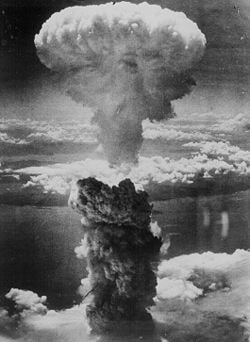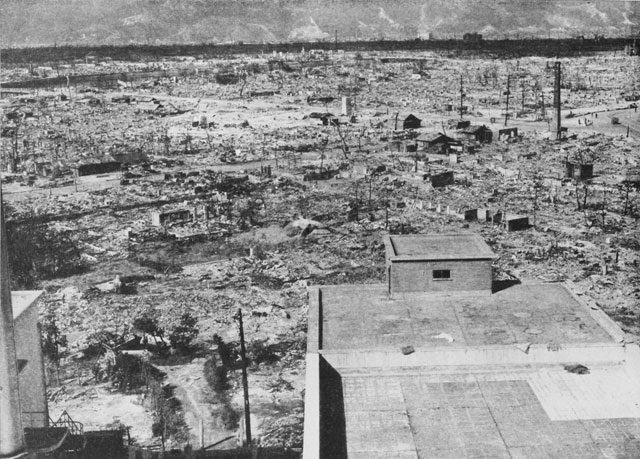bombing of hiroshima and nagasaki
For six months before the atomic bombings, the United States intensely fire-bombed 67 Japanese cities. Together with the United Kingdom and the Republic of China, the United States called for a surrender of Japan in the Potsdam Declaration on July 26, 1945. The Japanese government ignored this ultimatum. By executive order of President Harry S. Truman, the U.S. dropped the nuclear weapon "Little Boy" on the city of Hiroshima on Monday, August 6, 1945, followed by the detonation of "Fat Man" over Nagasaki on August 9.
Within the first two to four months of the bombings, the acute effects killed 90,000–166,000 people in Hiroshima and 60,000–80,000 in Nagasaki, with roughly half of the deaths in each city occurring on the first day. The Hiroshima prefectural health department estimates that, of the people who died on the day of the explosion, 60% died from flash or flame burns, 30% from falling debris and 10% from other causes. During the following months, large numbers died from the effect of burns, radiation sickness, and other injuries, compounded by illness. In a U.S. estimate of the total immediate and short term cause of death, 15–20% died from radiation sickness, 20–30% from flash burns, and 50–60% from other injuries, compounded by illness. In both cities, most of the dead were civilians.
On May 10–11, 1945, the Target Committee at Los Alamos, led by J. Robert Oppenheimer, recommended Kyoto, Niigata, Hiroshima, Yokohama, and the arsenal at Kokura as possible targets. The target selection was subject to the following criteria:
On July 26, Truman and other Allied leaders issued the Potsdam Declaration outlining terms of surrender for Japan. It was presented as an ultimatum and stated that without a surrender, the Allies would attack Japan, resulting in "the inevitable and complete destruction of the Japanese armed forces and just as inevitably the utter devastation of the Japanese homeland". The atomic bomb was not mentioned in the communique. On July 28, Japanese papers reported that the declaration had been rejected by the Japanese government. That afternoon, Prime Minister Kantarō Suzuki declared at a press conference that the Potsdam Declaration was no more than a rehash (yakinaoshi) of the Cairo Declaration and that the government intended to ignore it (mokusatsu, lit. "kill by silence"). The statement was taken by both Japanese and foreign papers as a clear rejection of the declaration. Emperor Hirohito, who was waiting for a Soviet reply to noncommittal Japanese peace feelers, made no move to change the government position. On July 31, he made clear to his advisor Kōichi Kido that the Imperial Regalia of Japan had to be defended at all costs.

of Hiroshima and Nagasaki

Nagasaki bombing

of Hiroshima and Nagasaki

Previous (Bombing of Dresden

Aerial view of Nagasaki cloud

another bomb on Nagasaki

bombing of Hiroshima and

OF HIROSHIMA AND NAGASAKI

part of Nagasaki City,

bombing of Hiroshima and

of Hiroshima and Nagasaki
.jpg)
of Hiroshima and Nagasaki

the bombing of Nagasaki

HIROSHIMA--from the top of the

------Hiroshima-----Nagasaki--

Hiroshima and Nagasaki
Within the first two to four months of the bombings, the acute effects killed 90,000–166,000 people in Hiroshima and 60,000–80,000 in Nagasaki, with roughly half of the deaths in each city occurring on the first day. The Hiroshima prefectural health department estimates that, of the people who died on the day of the explosion, 60% died from flash or flame burns, 30% from falling debris and 10% from other causes. During the following months, large numbers died from the effect of burns, radiation sickness, and other injuries, compounded by illness. In a U.S. estimate of the total immediate and short term cause of death, 15–20% died from radiation sickness, 20–30% from flash burns, and 50–60% from other injuries, compounded by illness. In both cities, most of the dead were civilians.
On May 10–11, 1945, the Target Committee at Los Alamos, led by J. Robert Oppenheimer, recommended Kyoto, Niigata, Hiroshima, Yokohama, and the arsenal at Kokura as possible targets. The target selection was subject to the following criteria:
On July 26, Truman and other Allied leaders issued the Potsdam Declaration outlining terms of surrender for Japan. It was presented as an ultimatum and stated that without a surrender, the Allies would attack Japan, resulting in "the inevitable and complete destruction of the Japanese armed forces and just as inevitably the utter devastation of the Japanese homeland". The atomic bomb was not mentioned in the communique. On July 28, Japanese papers reported that the declaration had been rejected by the Japanese government. That afternoon, Prime Minister Kantarō Suzuki declared at a press conference that the Potsdam Declaration was no more than a rehash (yakinaoshi) of the Cairo Declaration and that the government intended to ignore it (mokusatsu, lit. "kill by silence"). The statement was taken by both Japanese and foreign papers as a clear rejection of the declaration. Emperor Hirohito, who was waiting for a Soviet reply to noncommittal Japanese peace feelers, made no move to change the government position. On July 31, he made clear to his advisor Kōichi Kido that the Imperial Regalia of Japan had to be defended at all costs.

of Hiroshima and Nagasaki

Nagasaki bombing

of Hiroshima and Nagasaki

Previous (Bombing of Dresden

Aerial view of Nagasaki cloud

another bomb on Nagasaki

bombing of Hiroshima and

OF HIROSHIMA AND NAGASAKI

part of Nagasaki City,

bombing of Hiroshima and

of Hiroshima and Nagasaki
.jpg)
of Hiroshima and Nagasaki

the bombing of Nagasaki

HIROSHIMA--from the top of the

------Hiroshima-----Nagasaki--

Hiroshima and Nagasaki

0 Comments:
Post a Comment
Subscribe to Post Comments [Atom]
<< Home